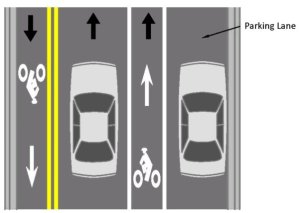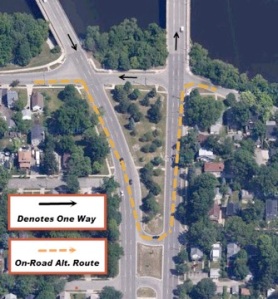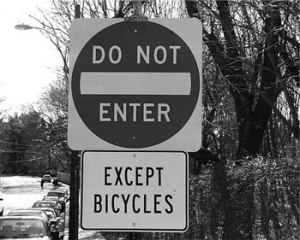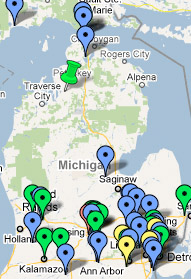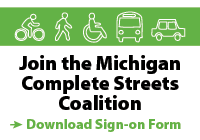You are currently browsing the tag archive for the ‘Complete Streets’ tag.
This post continues an ongoing blog series highlighting various complete street elements, their benefits, and use in Michigan communities. Check back often to catch future posts, and keep a lookout for contra-flow bike lanes in your community!
What are Contra-flow Bike Lanes? Contra-flow bike lanes allow legal bicycle access to riders wishing to bike in the opposite direction of traffic flow on one-way streets, creating two-way bicycle access on a one-way street. Contra-flow lanes are placed on the right side of a one-way street (from a bicyclist’s perspective traveling against traffic; from a motorist’s perspective, the lane would be on his or her left). A double-yellow line separates the contra-flow lane from traffic. Because the lanes take bicyclists in the opposite direction of traffic, signage plays an integral role in maintaining safety. “Do Not Enter” and “Bikes Only” signs should be placed at intersections to ensure vehicles do not travel the wrong way.
Why Use Contra-flow Bike Lanes? Contra-flow bike lanes increase connectivity for bicyclists and reduce dangerous wrong-way riding on one-way streets. A great example of how contra-flow lanes accomplish these goals is MDOT’s Martin Luther King/M-99 contra-flow lane. Josh DeBruyn, MDOT Bicycle and Pedestrian Coordinator, reports that prior to installation “cyclists would either cross the road illegally, transition to sidewalk, or travel nearly 10 times the distance while navigating 6 lanes of traffic to make a “Michigan left” to avoid the one-way street, when in reality the bicyclists simply wants to travel straight 150 feet.” In the right situation, contra-flow lanes can be extremely beneficial.
When to Use Contra-flow Bike Lanes: The appropriateness of contra-flow lanes is dependent on bicycling traffic volumes, incidences of wrong-way riding, nearby destinations, vehicle traffic volumes, and road characteristics. The National Association of City Transportation Officials (NACTO) lists several scenarios where contra-flow lanes may be appropriate:
- On streets where large numbers of bicyclists are already riding the wrong way.
- On corridors where alternate routes require excessive out-of-direction travel.
- On corridors where alternate routes include unsafe or uncomfortable streets with high traffic volumes and/or no bicycle facilities.
- On corridors where the contra-flow lane provides direct access to destinations on the street under consideration.
- Where two-way connections between bicycle facilities are needed along one-way streets.
- Work best on low-speed, low volume streets to minimize the risk of dangerous crashes.
Because contra-flow lanes are counterintuitive to drivers, education and outreach efforts are vitally important at the time of installation. Extra signage at driveways and minor intersections will help improve safety. Installing “No Turn On Red” signs at signal-controlled intersections is recommended by NACTO, and would increase safety for bicyclists where drivers make left turns.
Safety Benefits: Because contra-flow lanes formalize wrong-way riding on one way streets, drivers are better notified of bicyclists’ presence. Contra-flow lanes also allow bicyclists to avoid high-traffic detours, where crossing over multiple lanes poses a significant safety risk.
What Drivers Should Know: Drivers should expect to encounter bicyclists in both directions. When making left-hand turns, drivers need to make sure the contra-lane is clear of bicyclist traffic. Passing other drivers in contra-lanes is prohibited, and drivers should be careful not to cross the double-yellow lines.
Cost Considerations: Installation of contra-flow bike lanes should be done in conjunction with road resurfacing, where possible, to reduce costs. Costs will vary greatly depending on the length of the proposed bike lane and the extent of signage needed.
Contra-flow bike lanes are relatively new in Michigan. The Martin Luther King/M-99 contra lane was the first one put in by MDOT. If you have a contra-flow bike lane in your community, please Let us know!
Check out these resources for more information:
NACTO Guidance on Contra-flow Bike Lanes
Federal Highway Administration Guidance
Biking in Bloomington, IN: Contra-flow Lanes
Next Topic: Mid-Block Pedestrian Islands Explained
Previous Topic: Pedestrian Hybrid Beacons (HAWK Signals) Explained
 We’re excited to welcome Holly Madill, the new Project Coordinator for the Michigan Department of Community Health’s own Michigan Complete Streets program. This program aims to implement state and local Complete Streets policies to increase access to opportunities for physical activity in communities. MDCH is currently working with eight communities to implement Complete Streets policies.
We’re excited to welcome Holly Madill, the new Project Coordinator for the Michigan Department of Community Health’s own Michigan Complete Streets program. This program aims to implement state and local Complete Streets policies to increase access to opportunities for physical activity in communities. MDCH is currently working with eight communities to implement Complete Streets policies.
Holly holds a master’s degree in urban and regional planning and a bachelor’s degree in environmental science. Prior to coordinating the Complete Streets program, Holly provided consulting services, specializing in grant and project management, to nonprofits, private foundations, universities, and local units of government.
Good luck, Holly!
Holly Madill
Complete Streets Project Coordinator
(517) 335-8372
[email protected]
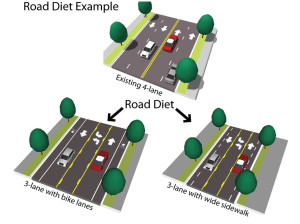 The Michigan Chapter of the American Planning Association published an extensive and explanatory article about complete streets in its monthly magazine, the Michigan Planner. A word version of the article, written by Brad Strader, can be downloaded here. Great work!
The Michigan Chapter of the American Planning Association published an extensive and explanatory article about complete streets in its monthly magazine, the Michigan Planner. A word version of the article, written by Brad Strader, can be downloaded here. Great work!
 After months of hard work and deliberation, the Michigan House of Representatives passed Complete Streets legislation in overwhelming fashion! H.B. 6151 passed with a vote of 85 - 21, and H.B. 6152 with a vote of 84-22. The Coalition would like to thank everyone for their support and testimony…congratulations! Now it’s on to the Senate Transportation Committee.
After months of hard work and deliberation, the Michigan House of Representatives passed Complete Streets legislation in overwhelming fashion! H.B. 6151 passed with a vote of 85 - 21, and H.B. 6152 with a vote of 84-22. The Coalition would like to thank everyone for their support and testimony…congratulations! Now it’s on to the Senate Transportation Committee.
Media:
Here’s a cool blog post and infographic from good.is on the rising popularity of people powered transportation. With the Michigan House of Representatives scheduled to vote on the Complete Streets legislation, this is particularly timely. Passing the legislation will make it even easier for Michigan citizens to continue to increasingly choose walking and biking over automobiles.
“It’s summer, and you may be seeing more people out on the street walking and biking. But it’s not just because the weather is nice. There are more people walking and biking year round, and the Department of Transportation is responding by dramatically increasing the amount of money spent on projects for pedestrians and cyclists.”
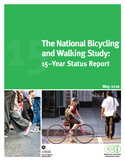 The infographic is derived from the 15-year Status Report, which is the third status update to the National Bicycling and Walking Study, originally published in 1994 as an assessment of bicycling and walking as transportation modes in the United States. The report gives an update on the two main goals of the 1994 study: reducing fatalities and increasing the number of trips made by walking and biking. The good news is that improvements were made in both, but funding for these alternatives to automobiles still accounts for only about 2% of transportation funding, so there’s still some work to do. The report also notes that “one of the fastest-growing efforts to promote bicycling and walking is the adoption of Complete Streets policies.”
The infographic is derived from the 15-year Status Report, which is the third status update to the National Bicycling and Walking Study, originally published in 1994 as an assessment of bicycling and walking as transportation modes in the United States. The report gives an update on the two main goals of the 1994 study: reducing fatalities and increasing the number of trips made by walking and biking. The good news is that improvements were made in both, but funding for these alternatives to automobiles still accounts for only about 2% of transportation funding, so there’s still some work to do. The report also notes that “one of the fastest-growing efforts to promote bicycling and walking is the adoption of Complete Streets policies.”
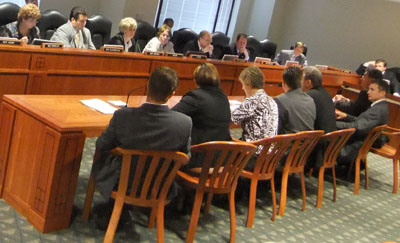
R to L: A panel of supporters including the County Road Association of Michigan, Michigan Environmental Council, Michigan Fitness Foundation, Michigan Municipal League, Michigan Trails and Greenways Alliance, AARP and Representative Jon Switalski testifying in support of HB 6151 and 6152.
The House Transportation Committee voted unanimously to pass HB 6151 and HB 6152 out of committee, with recommendations. This is a big success for Complete Streets, and the Coalition would like to thank all of the stakeholders who worked hard to negotiate a bill that was eventually able to garner such strong support. We would especially like to thank Rep. Wayne Schmidt for his leadership on this issue, as well as Rep. Pam Byrnes, Rep. John Switalski and their staffs, who put a lot of effort to achieve this victory. In hectic fashion, the final drafts of the bills were being revised right up to the last minute, modified to reflect the negotiations made between all parties involved. As Chairwoman Byrnes said, reflecting on the compromises reached, “This bill is not what everybody wants, but it’s a good step forward.”
As the result of negotiations MML, SEMCOG, MDOT and CRAM, many of whom had previously only supported the bills in concept, are now strong supporters of the legislation. The support of these organizations, in addition to the support of most of the GOP members of the committee, bodes well for the future of the bills.
The final revision of the bill no longer requires local road agencies or municipalities to pass their own Complete Streets policies. MDOT, however, is still required to pass a Complete Streets policy, along with a ‘model’ policy for municipalities and counties. As Rep. Switalski said, this version of the bill gives “cities, and locals more say when dealing with transportation policy.” The final bill also gives the Complete Streets Advisory Council a much stronger role in the planning process, allowing them to advise MDOT on the adoption of Complete Streets policies.
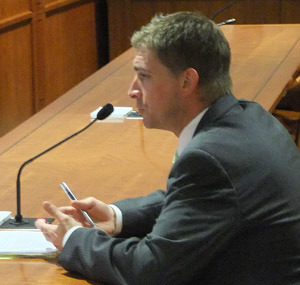
Bill sponsor, Representative Jon Switalski, makes the case for Complete Streets in Michigan before the House Transportation Committee on June 24th, 2010. The Committee went on to vote unanimously in support of the legislation.
Felicia Wasson from AARP used her brief testimony to rightly note that this is “only the beginning - a first step” for Complete Streets. According to the revision, Complete Street policies must consider the “varying mobility needs of all legal users of the roadway, of all ages and abilities.” This language does indeed represent a great first step towards ensuring that everyone is entitled to use roadways safely and conveniently.
The bills will now be referred to the House floor for a second reading, followed by a vote by the full House of Representatives. Rep. Byrnes expects that the bills will be voted on by the House relatively soon. After that, they are on to the Senate committee. It’s important to keep the energy and enthusiasm alive as the bills move forward - look for an updated action alert on our Take Action page in the next few days.
(For a complete look at the process the bills will follow as they become law, download a PDF copy of the Michigan Citizens Guide to State Government)
The Coalition would like to once again thank everyone who has worked with us to see that these bills get passed. Let’s use today’s success as a springboard to redouble our efforts, and push these important bills out of the House and through the Senate!
Additionally, League of American Bicyclists, Alliance for Biking and Walking, and the National Complete Streets Coalition all featured the efforts of Michigan’s Complete Streets movement on their blogs today.
Many more organizations and individuals provided testimony in support of Compete Streets that was entered into the record at the committee meeting as well. The following is list of links to .pdfs of those testimonies.
- Sarah Panken, Active Communities Coordinator for the Michigan Fitness Foundation
- Susan Hargter, Cyclesafe, Inc.
- Robert Prud’homme, LEED for Neighborhood Development, USGBC- Detroit Regional Chapter
- Barbara Kramer, Candidate for Dickinson County Comissioner
- MC Rothhorn, Mid-Michigan Environmental Action Council
- Jim Briggs and Carolyn Grawi, Ann Arbor Center for Independent Living
- Frank Lynn, Concerned Citizens for Improved Transit
- Dave Bulkowski, Disability Advocates of Kent County
- Gary Howe
- Michael Aughenbaugh, Revex, Inc.
- Steven A Roach
- Michael Maisner, Michigan Fitness Foundation
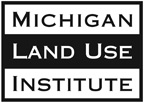 Thanks to Brian Beauchamp of the Michigan Land Use Institute for his recent blog post supporting the Complete Streets legislation currently before the House Transportation Committee. In addition to traveling to Lansing to voice support before the House Transportation Committee, MLUI posted a call to action on their blog earlier this week.
Thanks to Brian Beauchamp of the Michigan Land Use Institute for his recent blog post supporting the Complete Streets legislation currently before the House Transportation Committee. In addition to traveling to Lansing to voice support before the House Transportation Committee, MLUI posted a call to action on their blog earlier this week.
 We would also like to thank the Michigan League of Conservation Voters for their recent article expressing support of HB 6151 and 6152. “The Michigan House is pedaling good policy in this case,” said Lisa Wozniak, executive director of the Michigan League of Conservation Voters
We would also like to thank the Michigan League of Conservation Voters for their recent article expressing support of HB 6151 and 6152. “The Michigan House is pedaling good policy in this case,” said Lisa Wozniak, executive director of the Michigan League of Conservation Voters
The Michigan Municipal League (MML) is asking folks to sign a petition of support for Complete Streets on their Let’s Save Michigan website. They recently featured the Complete Streets design principle at their Capitol Conference, and brought national walkability expert Dan Burden to a number of Michigan communities in February.
We are extremely pleased to see that the Let’s Save Michigan blog is asking people to contact their legislators to support HB 6151 & 6152. While MML has been supportive of the idea of Complete Streets, they have not officially thrown their support behind these specific bills. MML’s testimony last week before the House Transportation Committee stated that they only support these bills “in concept.”
We expect the House Transportation Committee to vote on these bills this Thursday, June 17. We’ll keep you updated.
The map below highlights the various businesses and organizations throughout the state who have joined the MI Complete Streets Coalition.
Legend:
| Category | National and/or Statewide | Regional and/or Local |
| Environmental/Land Use | ||
| Disability/Aging | ||
| Bicycling | ||
| Health/Wellness | ||
| Transit | ||
| Engineering/Planning | ||
| Trails | ||
| Economic/Development | ||
| Other |
Want to get your organization on the map? Join the MI Complete Streets Coalition today!
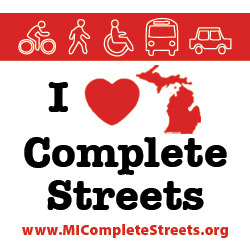 Please help us promote the Michigan Complete Streets Coalition by putting one of our badges on your website or blog. Our Promotions Page has various graphics, as well as information on how to show your support for MCSC on on your Facebook page.
Please help us promote the Michigan Complete Streets Coalition by putting one of our badges on your website or blog. Our Promotions Page has various graphics, as well as information on how to show your support for MCSC on on your Facebook page.
Please reserve the “member” badges for Coalition partners. If you have not yet signed-on as an official coalition partner, you may do so here.

